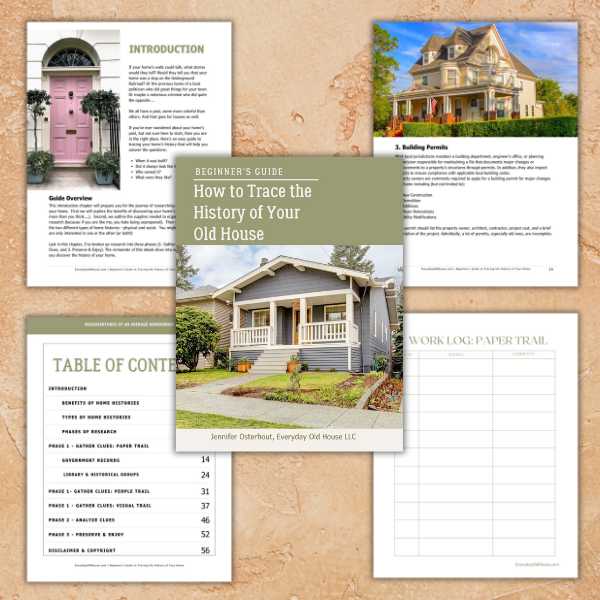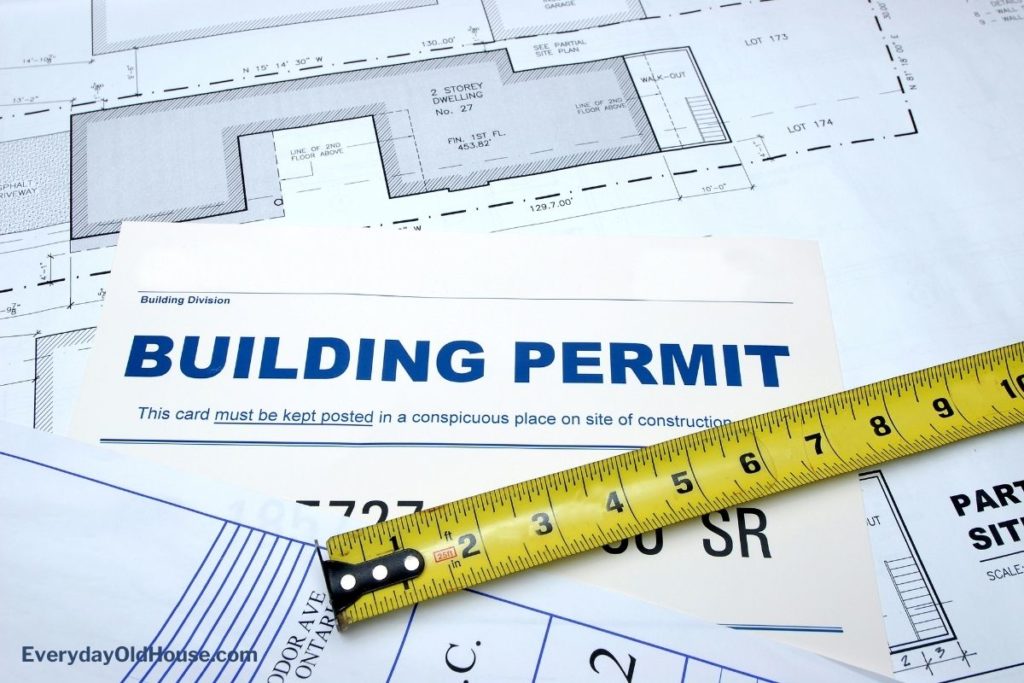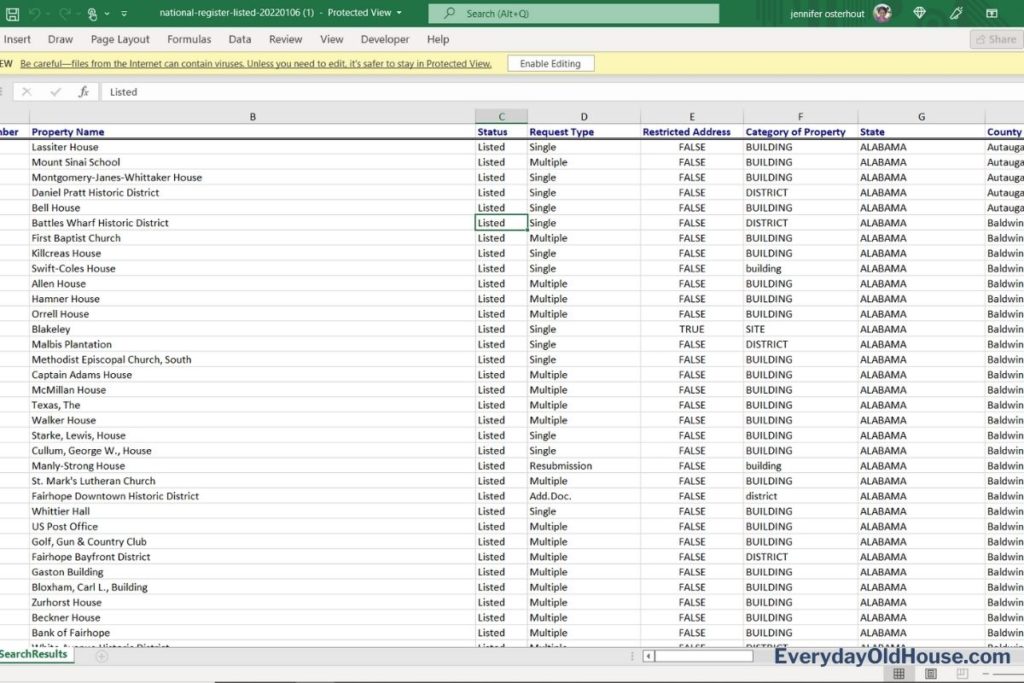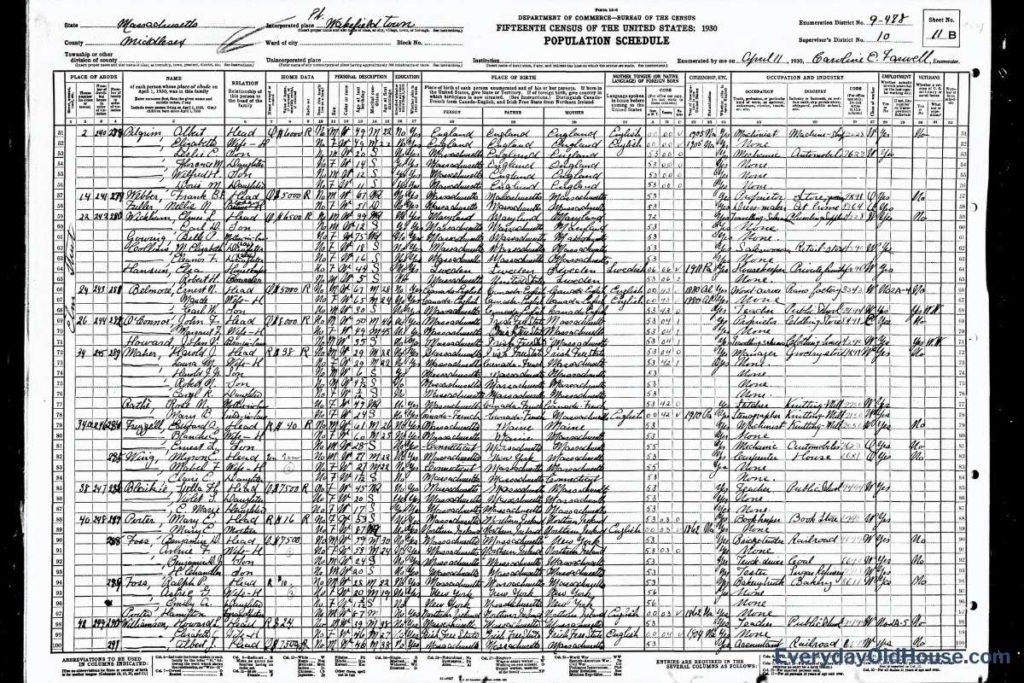Various levels and branches of your state and local government collect information on your house over time, such as deeds, plat maps, mortgages, liens, tax records, building permits, etc…. And if you know where to look, these files can be a treasure trove of information about your house. Here’s 7 government records for home history research worth checking out!

BEGINNER’S GUIDE TO HOME HISTORY RESEARCH
Interested in researching the history of your old house but unsure where to start? Grab my newly-release:
Beginner’s Guide: How to Trace the History of Your Old House
This 60-page guide takes you step-by-step through 25+ online and in-person resources to create a picture of your home’s history.

7 Government Records for Home History Research
There are SO many ways to research the history of your house, including local library archives, neighbors, historical society, and the topic of this post – government records.
These resources can easily be divided into the “paper” and “people” trails. This post focuses on the paper trail (if interested in how to interview people about the history of your house, click here).
You might be surprised by how much information is available through government records for home history research. And, luckily, several of these resources are available online, and are either free or low cost to obtain.
Tips Before Starting….
- Unfortunately, every state, county, and city/town agency formats and organizes their database differently using various technologies. UGH! To save time and avoid frustration, reach out directly to an employee for help.
- If you get stuck with state or local research, visit the Public Records Online Directory. This site is a portal to state and local government offices that have online databases with available online public records. Click on the state where you reside on the interactive map, followed by the county. Depending on how your state is organized, there may also be a breakdown by municipality. Click on the appropriate link and you will see the various agencies that maintain public records.
1. Deed Registrar
A deed is a legal written document that records the sale of a property. In other words, if you hold the deed, then you prove ownership to the property. If you want to get fancy, a deed transfers title (aka “ownership”) from a seller (the “Grantor”) to the buyer (the “Grantee”).
Commonly, a county’s Registry or Recorder of Deeds collects and records all deeds. Some recorders have on-line databases allowing you to research from the comfort of your own home, while others require you research in-person at their offices.
Or, some counties (like mine) provide only recent deeds online (e.g. the last 30 years). If you want to look at older deeds, a trip to the registry is required.
Tip: If you are looking for deeds on-line, make sure that you are on the official Registry website and not a business website that will charge you for the information.
Useful Information from Deed
A deed is a complicated legal document, which consists of multiple pages and a lot of information. As the average homeowner, I found some of the deed difficult to interpret. And downright tedious. BUT not to worry. If you just researching the history of your house, these 3 components of the deed will probably be the most useful. And luckily, these are relatively easy to find.
1. Grantors and Grantees
The deeds document the names of the sellers and buyers (aka the Grantors and Grantees). Older deeds may even reference the Grantor and Grantee’s occupation.
2. When and How Property Conveyed
Deeds outline the date of transaction, the type of deed, and consideration (i.e. how much money). Commonly it will be an agreement of sale between individuals. But you might find that the property was sold as part of a government sale (see #7 below) or inheritance.
3. Major Property Features
Deeds are mainly concerned with ownership of land, not structures. Therefore it usually gives the description of the land, including surveyed boundaries. However, in addition to describing the boundary of land, it may list structures such as a house, garage and outhouses (sometimes referred to as “improvements”).
How to Create a Chain-of-Title
If you own an old house, it’s likely passed through several hands over the years. And there should be a corresponding deed for each transaction. Gathering all the deeds for a property and connecting them in chronological order creates a “chain” of ownership, or “chain-of-title”.
Tip: To create a chain-of-title, begin with the most recent deed (aka yours!) and follow it back in time.
2. Tax Records
Taxpayers in every state (and District of Columbia) pay property taxes, which is a tax levied on “real property” (i.e., land and buildings). This money is used to support local infrastructure, public services and schools.
Responsibility for collecting these taxes falls at the local government branch level, usually through the Tax Assessor or Tax Appraiser. This department is responsible for assessing the value of homes within their jurisdiction, collecting property taxes, and maintaining a historic tax record. While some tax collectors still require an in-person visit to review records, many communities have moved to an online system.
Tip: In some geographical areas, the tax assessor and collector may be divided into two different departments.
This department maintains a property record for each taxed property by both address as well as an associated Land or Parcel ID number. It’s important to grab this ID number. It may come in handy for searching other public record databases. The assessor should also have plat maps that show your property by ID number in relation to the rest of the neighborhood. Plat maps are surveyed maps drawn to scale that record official boundaries and acreages of properties.

You can learn an amazing amount from these government records for home history research with regards to Tax History and Physical History.
Tax History
The tax history roll is an annual record of your property’s assessed value and past taxes paid. In addition, it will also note any taxes are due, or if there are any liens on the property.
As expected, you will commonly see an overall steady increase in assessed value (and increased taxes) over the years. But if you see an abrupt increase (or decrease) in assessed value, that could indicate a major change at the property (i.e. house construction or renovation, or even demolition).
Physical History
In addition to taxes, the property record can also provide detailed information on the physical aspects of your property. For example, my town’s property records include the following:
- Construction Date
- Architectural Style
- Property Acreage
- Structure Square Footage
- Number of Rooms and Baths
- Foundation and Frame Type
- Roof and Siding Composition
- Heating Source
- Sales Date, Price, and Previous Owners
Property records also usually contain a “Comments” or “Notes” section. This is where you may find details on past renovations including photos or architectural drawings of your house.
3. Building Permits
Most local jurisdictions maintain a building department, engineer’s office, or planning commission responsible for maintaining a file that documents major changes or improvements to a property’s structures through permits. In addition, they also inspect projects to ensure compliance with applicable local building codes.
Property owners are commonly required to apply for a building permit for major changes to a home including (but not limited to):
- New Construction
- Demolition
- Additions
- Major Renovations
- Utility Modifications
Each permit should list the property owner, architect, contractor, project cost, and a brief description of the project. Admittedly, a lot of permits, especially old ones, are incomplete.

To get an idea of the physical changes of your home over the years, request or “pull” the permits for your address (or Parcel ID). Perhaps you’ll find an old demolition permit that removed an old structure on your property. Or the construction permit for your current home, or addition. Or the permit associated for electrical upgrades that confirms the removal of knob and tube.
There may even be original architectural plans of the house, telling you which rooms were original to the house. (How awesome would that be!?!?!)
Building permit files can be tricky to understand, so if given the opportunity, speak directly with an Inspector. You may get luck and discover that they may be a decades-long employees who can shed some light on interpreting your permits.
4. Public Utilities
If your state or local government supplies electricity, gas, water, sewer, etc to your home, there should be a public record on activity. In addition, the local fire department should have a logbook which may document a fire at your home and outline the extent of fire damage.
These departments should have utility hook-up dates for your house. If they don’t have a specific record for your house, they may have it for the street or neighborhood. This connection date commonly matches as your home’s construction year. However, if your house pre-dates utility water and sewer connection, there probably was a water well and privy somewhere on your property.
Note that commonly the first utility provided to many municipalities was water and sewer service. So don’t be surprised if there is a gap between the installation dates of water and sewer versus electrical and gas.
Also be open to dates that indicate a conversion of the fuel used by its heating, ventilation and air conditioning (HVAC) heating sources. For example, we converted from oil to gas heat after decades using oil heat.
5. U.S. Federal Census
Census records will tell you less direct information about the physical aspects of your home. But they can paint a fascinating story about the people who lived in it.
The U.S. federal government has conducted a Federal Population Census every 10 year since 1790 (wow!). Information gathered in the early days of the Census were limited. But starting 1850, an impressive amount of detail was collected and organized by address, including:
- Property Value
- Occupant Names
- Owners or Renters
- Relation to Head of Household
- Ages
- Marital Status
- Education
- Birthplace
- Parents Birthplaces
- Citizenship
- Employment Status
- Farm Status
The Federal Census records are available online through a handful of ways. Unfortunately due to a 72-year restriction on access to the Census, the most recent census currently available is 1950.
Searching the census records can be tricky. Click here for my tutorial on how to navigate.
6. National, State, and Local Historical Registers
If you own an older house (aka at least 50 years old) you might want to check out the national, state, and local registers of historic places to see if your property is listed.
National Register of Historic Places
The National Register of Historic Places (NRHP) is a program of the National Park Service, where properties that are designated as historically significant due to the age or architectural style are recorded. It’s the U.S. federal government’s official list of buildings (including homes), sites, districts, structures and objects deemed historically significant and worthy of preservation.
The NRHP has both a searchable database and downloadable spreadsheet. Personally, I find the downloadable spreadsheet more user-friendly. The spreadsheet is easily scannable by property’s historical name (e.x. Bell House), state, county and street (or intersection) address.

State Historic Preservation Office
If you don’t find a listing on the National Register of Historic Places, you might want to continue research at the state level. Every state has a State Historic Preservation Office (SHPO) that also creates and maintains their own register of significant properties. Start here to find your state’s SHPO.
Local Registry
Some states, such as Massachusetts, have empowered local governments to create a Historical Commission or Board, which creates and maintains its own list of historic sites at the local level. Reach out to your local government to see such a board exists, and if so, if your home is on the local list.
7. Bureau of Land Management (BLM)
This federal agency maintains General Land Office (GLO) Records of federal land conveyance records for Public Land States as far back as 1788. Let’s back up a minute…
During the 1800s, the U.S. rapidly expanded into the Midwest to the West Coast. As part of this endeavor, federal and state governments sold tracts of land to generate revenue (for example, the Homestead Act of 1862). These transfers of public lands to individuals were referred to either “grants” or “patents”, and intended for creation of farms.
The BLM GLO Records contain the federal government or “public land” transactions which occurred in the following states, divided into Eastern and Western:
Eastern States
| Alabama | Arkansas | Florida | Illinois |
| Indiana | Iowa | Louisiana | Michigan |
| Minnesota | Mississippi | Missouri | Ohio |
| Wisconsin |
Western States
| Alaska | Arizona | California | Colorado |
| Idaho | Kansas | Montana | Nebraska |
| Nevada | New Mexico | North Dakota | Oklahoma |
| Oregon | South Dakota | Utah | Washington |
| Wyoming |
If your state isn’t listed above, then land conveyance was conducted at the state government level. Records should be housed in your state’s archives.
There is a variety of information you can pull from the BLM GLO Records website. They maintain many online searchable databases including Land Patents, Survey Plats and Field Notes, Land Status Records (LSR), Control Document Index Records (CDI) and Tract Books, which holds information such as:
- Patent Applicant
- Transaction Date
- Type of Patent or Transaction
- Applicable Land Office
- Acreage
- Legal Property Description
- Government or Mineral Reservations
From a personal perspective, these databases were fascinating! I could easily go down a rabbit hole…
My Home History – Government Records for Home History Research
Using these government records for home history research for my property, I was able to gather an interesting picture of my home. From the deed research, I created a chain-of-title of previous owners. The tax records confirmed the physical structure of my house (including the installation of our random basement toilet). And surprised me that our detached garage was actually built about two decades after the house.
Truth be told, the census research was the most interesting. The 1940 and 1930 census told me about my home’s occupants – a husband and wife who married when they were in their 40s. He owned a clothing store, she a housewife. The both had Irish-born parent who married a U.S. citizen. And in the 1940s, they housed the wife’s younger brother, a war Veteran and traveling salesman.
Unfortunately the building department nor the public utilities had any records on my property. And since I live in Massachusetts, the BLM GLO Records do not apply to my location.
Related Posts
Disclaimer
I am not a professional home genealogist (nor play one on tv….). However, as a environmental consultant for 10+ years, I researched the history of 100+ commercial properties for property owners, potential buyers, and real estate developers. I utilized a variety of historical databases and resources – historical maps, government databases, interviews, and property visual clues – to create a picture of a property’s past.
My mission is to use these consulting skills (combined with genealogy classes) to help other homeowners to research the history of houses.
Note that my experience is limited to the United States. For European homes, I suggest this website.
Want to be the first to know about new posts? Be sure to follow me on Pinterest, Facebook, Instagram or Twitter of even Etsy! Or better yet… Subscribe below!
My monthly (admittedly sometimes more, sometimes less….) emails are like receiving a unexpected letter from an old friend WITHOUT needing to put on your slippers and walk out to your mailbox…. See? I got ya, my friend!)
[Note: My posts are proudly connected to these amazing link parties full of DIY ideas and inspiration!]


